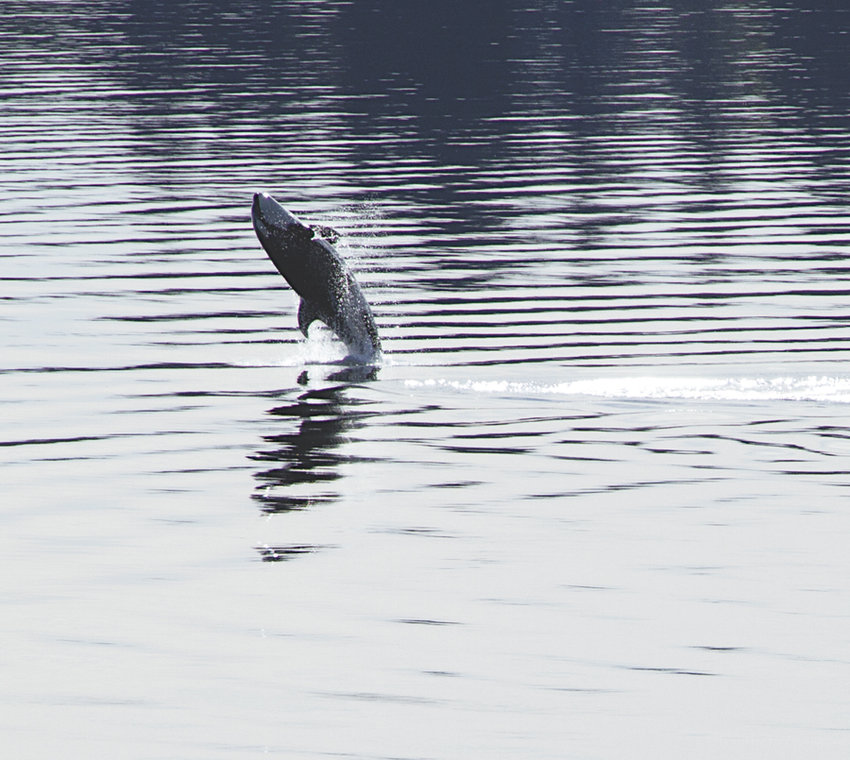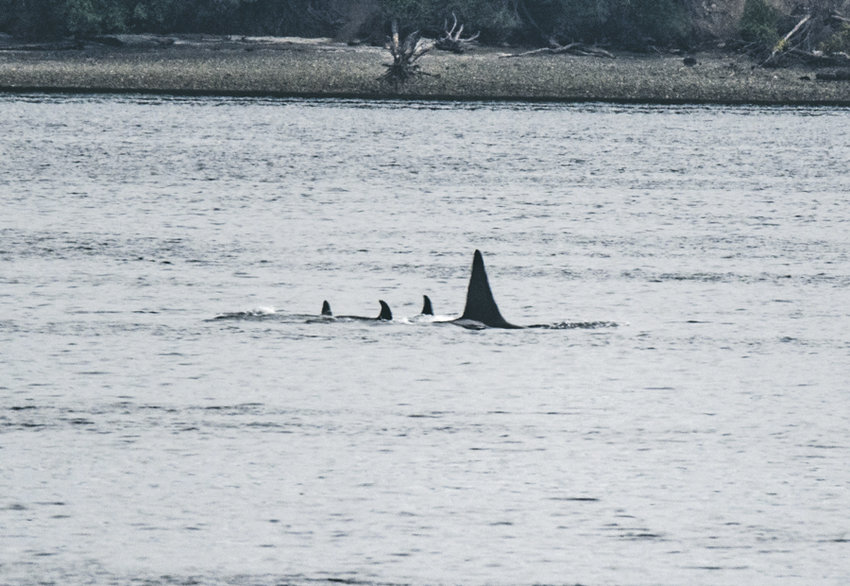 A young orca breaches in Case Inlet. Photo: Kathy Bauer
A young orca breaches in Case Inlet. Photo: Kathy Bauer
A pod of eight or more orcas visited the waters surrounding the Key Peninsula at the end of April for more than 10 days, according to local residents and whale researchers.
Ingrid Shumway, who lives on Henderson Bay just south of the Purdy Spit, first spotted orcas outside her window early on the morning of April 29. They had been heading south, she said, but then, “I noticed them coming back in along the shore.”
The whales stuck close to the shoreline and then entered Burley Lagoon. “They spent hours around here,” Shumway said. “It was quite a sight.” She said she had never seen orcas so close to shore or in the lagoon in the 25 years she and her husband have lived on the bay.
At least part of the group was identified as the T68 family, a pod of transient orcas (also known as Bigg’s orcas), according to the Orca Network, a group of scientists and volunteers who track whales in the Salish Sea.
On April 20, the matriarch of the family, T68, was spotted traveling with her son, T68A, daughters T68Bs and unidentified whales called Alaska Unknowns off Admiralty Inlet at the northern end of Puget Sound. The AK Unknowns were first spotted near Victoria, B.C., April 15, and had been seen only a few times before near Alaska, according to the BC Killer Whale Research Report group in Sydney, B.C.
 T68A, a male with the tall dorsal fin, heads south with family members in Henderson Bay. Photo: Ingrid Shumway
T68A, a male with the tall dorsal fin, heads south with family members in Henderson Bay. Photo: Ingrid Shumway
T68A was the large male seen entering Burley Lagoon. Orcas live in matrilineal groups, with all offspring usually remaining with their mother until death, even after reproducing. The T68 family was the only one in KP waters positively identified at press time, though other transients were seen with them.
Orcas are identified primarily by the condition of their dorsal fins and the distinct white saddle patches behind them, a technique pioneered by Michael A. Bigg, the late Canadian marine biologist whose research identified them as a distinct population.
Phil and Kathy Bauer, who live on Case Inlet south of Vaughn Bay, spotted half a dozen or more orcas, including calves, just off shore May 4. “They were breaching and tail slapping and just playing around,” Phil Bauer said. “We’ve seen them every once in a while over the years, but this was just incredible.”
Transient orcas do not have specific territories, but travel long distances in coastal waters to hunt marine mammals and birds close to shore. Their diet, hunting techniques and vocalizations set them apart from open ocean orcas and the local resident populations of the Salish Sea.
The large number of orcas and the length of their stay may be related to the unusual number of sea lions lingering in Home and the Rocky Creek areas. Orca Network confirmed a sea lion kill by transient orcas close to shore near Richmond Beach in north Puget Sound May 8.
About 80 orcas known as J Clan spend most of their lives feeding on salmon around the San Juan Islands and Strait of Georgia, though they occasionally enter Puget Sound proper and have been observed as far south as Monterey, California. The clan is made up of three families: J, K and L pods. Another resident population of about 200 whales in three clans—A, G and R—lives farther north in the waters around Vancouver Island. The two groups are not known to mix, interbreed or vocalize in the same dialect, according to the Center for Whale Research at Friday Harbor on San Juan Island.
Orcas can travel up to 100 miles a day and in short bursts of speed of 30 miles per hour. They live between 40 and 80 years, though one local matriarch, J2, also known as Granny, was thought to be 105 years old due to the number and age of her known descendants when she was last seen in October 2016.
Necropsies performed on resident orcas and orcas around the world have revealed high levels of industrial toxins accumulating in these apex predators, according to the Center for Whale Research. J Clan has lost about 20 percent of its members over the last two decades and is the only orca population in the world considered an endangered species.
For more information or to report any whale sighting, go to www.orcanetwork.org.
UNDERWRITTEN BY THE FUND FOR NONPROFIT NEWS (NEWSMATCH) AT THE MIAMI FOUNDATION, THE ANGEL GUILD, ADVERTISERS, DONORS AND PEOPLE WHO SUPPORT INDEPENDENT, NONPROFIT LOCAL NEWS